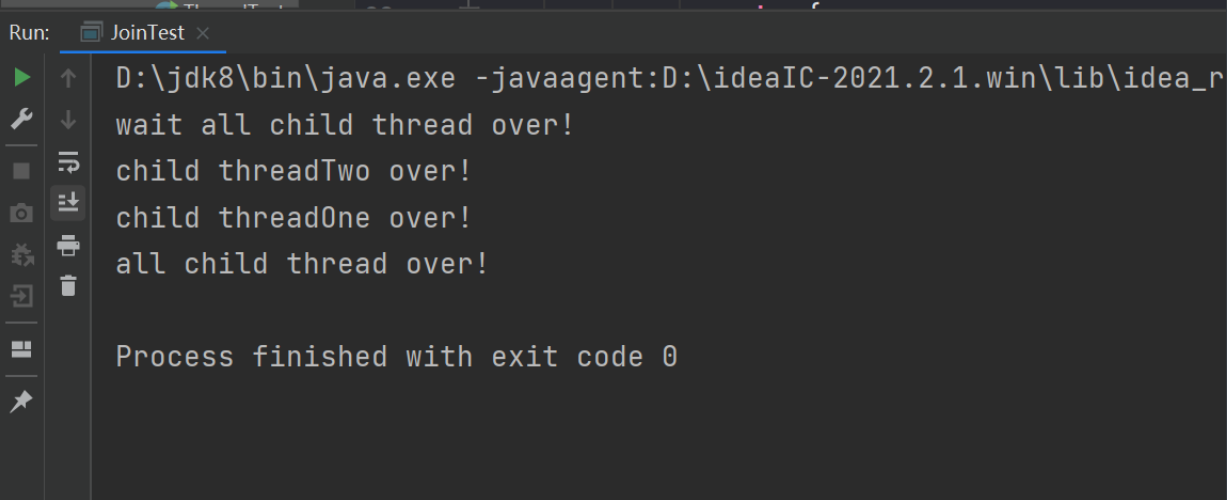3-等待线程终止的join方法
等待线程终止的join方法
-
在项目实践中经常会遇到一个场景,就是需要等待某几件事完成之后才能继续往下执行,比如线程加载资源等等。
package com.heiye.learn1; public class JoinTest { public static void main(String[] args) throws InterruptedException { Thread threadOne=new Thread(new Runnable() { @Override public void run() { try{ Thread.sleep(1000); } catch (InterruptedException e) { e.printStackTrace(); } System.out.println("child threadOne over!"); } }); Thread threadTwo=new Thread(new Runnable() { @Override public void run() { try{ Thread.sleep(1000); } catch (InterruptedException e) { e.printStackTrace(); } System.out.println("child threadTwo over!"); } }); //启动子线程 threadOne.start(); threadTwo.start(); System.out.println("wait all child thread over!"); //等待子线程执行完成,返回 threadOne.join(); threadTwo.join(); System.out.println("all child thread over!"); } }
-
如上代码在主线程里面启动了两个线程,然后分别调用了它们的join方法,那么主线程首先会调用threadOne.join()执行完毕后返回,然后主线程调用threadTwo.join()方法后再次被阻塞,等待threadTwo执行完毕后返回。
-
另外,线程A调用线程B的join方法会阻塞,当其他线程调用了线程A的Interrupt()方法中断了A时,线程A会抛出InterruptedException异常而返回。如下:
package com.heiye.learn1; public class JoinTest2 { public static void main(String[] args) { Thread threadOne = new Thread(new Runnable() { @Override public void run() { System.out.println("threadOne begin run!"); for (; ; ) { } } }); //获取主线程 final Thread mainThread = Thread.currentThread(); //线程two Thread threadTwo = new Thread(new Runnable() { @Override public void run() { //休眠1秒 try { Thread.sleep(1000); } catch (InterruptedException e) { e.printStackTrace(); } //中断主线程 mainThread.interrupt(); } }); //启动线程one threadOne.start(); //延迟1s启动线程two threadTwo.start(); try {//等待线程one结束 threadOne.join(); } catch (InterruptedException e) { //e.printStackTrace(); System.out.println("main thread: " + e); } } }
-
如上代码在threadOne线程里陷入死循环,主线程调用threadOne.join()方法阻塞自己等待线程threadOne执行完毕,在threadTwo休眠1s后会调用主线程的inerrupt()方法设置主线程的中断标志,从结果上来看,主线程的threadOne.join()会抛出InterruptedException异常,这里另外注意的是,在threadTwo里面调用的是是主线程的interupt()方法,而不是线程threadOne的。



【推荐】国内首个AI IDE,深度理解中文开发场景,立即下载体验Trae
【推荐】编程新体验,更懂你的AI,立即体验豆包MarsCode编程助手
【推荐】抖音旗下AI助手豆包,你的智能百科全书,全免费不限次数
【推荐】轻量又高性能的 SSH 工具 IShell:AI 加持,快人一步
· .NET Core 中如何实现缓存的预热?
· 从 HTTP 原因短语缺失研究 HTTP/2 和 HTTP/3 的设计差异
· AI与.NET技术实操系列:向量存储与相似性搜索在 .NET 中的实现
· 基于Microsoft.Extensions.AI核心库实现RAG应用
· Linux系列:如何用heaptrack跟踪.NET程序的非托管内存泄露
· TypeScript + Deepseek 打造卜卦网站:技术与玄学的结合
· 阿里巴巴 QwQ-32B真的超越了 DeepSeek R-1吗?
· 【译】Visual Studio 中新的强大生产力特性
· 10年+ .NET Coder 心语 ── 封装的思维:从隐藏、稳定开始理解其本质意义
· 【设计模式】告别冗长if-else语句:使用策略模式优化代码结构